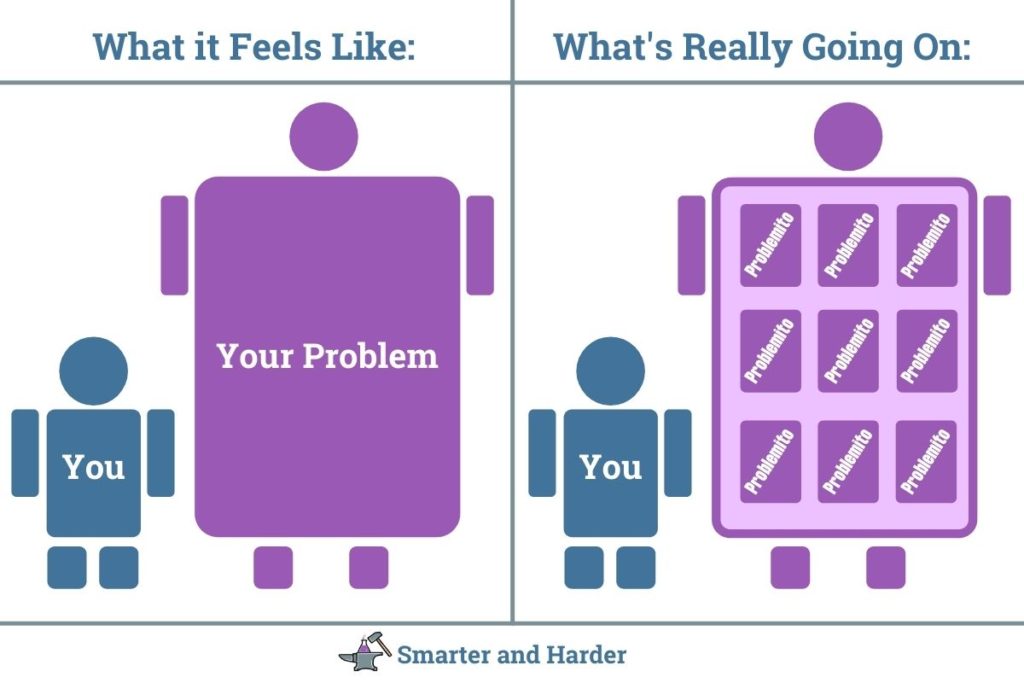Have you ever gotten yourself all worked up to solve a major challenge in your life? Was your solution to the problem to jump right in and go for it? This type of problem-solving approach is widespread, though it’s rarely the most effective. If you want to solve your problem reliably, you will be better off if you break down the problem into simpler parts.
A big goal, such as a significant life transition or a significant professional project, can feel overwhelming – especially at first. And even in comparatively smaller pursuits, making progress in the face of obstacles can go from mildly challenging to stressful in no time at all.
Usually, the first problem we need to solve is to realize that our big problem isn’t what we think it is: it’s actually a collection of more minor objectives all wrapped up in one. The solution to that problem, then, is also not one solution but a chain of small creative solutions.
Surmounting the Insurmountable
Like I always say when people start getting too chummy with me at social gatherings, let’s talk about software engineering for a minute.
When you work in software, you are often tasked to solve problems that, on the surface, seem practically insurmountable. Fortunately, what’s on the surface is something of an illusion.
When someone asks you to build an app, you don’t simply sit down and start building an app. Instead, you start by making a plan.
The trick to the problem-solving process is to break down the problem before you dash in trying to solve anything. This starts with foundational questions:
- What features does this product need to have?
- What will its components be?
- With which platforms or services does it need to communicate?
- What is the most basic version of this that we can call “done” and add more to later?
Before writing the first line of code (yet somehow, months after the product has already been widely sold to investors), you brainstorm a series of questions like these. Then, you can figure out the individual components that will make up the project. Before solving the problem, you first have to define the problem.
In all likelihood, each of these questions will yield multiple answers, each one a project of its own. And each of those projects, in turn, will contain many separate tasks.
The moral of the story is when you’re facing a hefty task or project, effective problem-solving means breaking the problem down into components. Then you can handle each of them, one by one.
One Problem or a Family of Sub-Problems?
This phenomenon, in which clusters of mini problems masquerade as giants, occurs constantly. Consider some of these examples:
- Moving to a new home
- Changing careers
- Planning a wedding or other large-scale event
- Losing weight
- Tackling a significant work project
- Improving your finances
Imagine your problem-solving method for any of these was to treat it as a single task to do in one fell swoop. A few words that may come to mind are: exhausting, terrifying, and “miss me with that.”
But that’s because (you guessed it) none of these is a single problem. Rather than some towering 7-foot monster, each is more like a bunch of tiny baby problems (problem-itos, if you will) standing on each other’s shoulders wearing a trench coat to fool you.

Take the first example, buying a house.
It’s a huge and emotionally charged undertaking. It’s intimidating, yet countless adults seem to navigate this collective problem and come out okay. They do that by decomposing one giant problem into many, each with its own constraints, objectives, and solutions:
- Figuring out what the budget will be
- Deciding style preferences
- Looking at neighborhoods
- Finding an agent or realtor
- Listing the current home
- Packing up to move
- And about two million others
Our ability to solve problems like these directly depends on our ability to separate out the individual problem-solving steps we will need.
Just because a collection of obstacles come nicely wrapped in a fancy cover with a single title doesn’t mean you must face them all as a single unit.
How to Break Down Problems into Simpler Parts (4 Steps)
Massive initiatives like these help to illustrate the idea. But they’re not the only times that this manner of creative step-by-step problem-solving can make a difference.
When you’re ready to embark on the next big challenge in your life, I encourage you to give the following steps a try. See if you can’t divide it into smaller problem-itos and conquer those. Remember, we’re not solving everything at once, just the next step.
Whether it’s an obstacle in your career, a goal to improve your physical, emotional, or financial wellness or any other daunting project, there is usually a different story hidden behind the trench coat.
1. Figure Out the Requirements
One of the most essential problem-solving skills you can build is effective brainstorming. That is, the ability to break down complex problems piece by piece.
To do that, you need to ask yourself the right questions about how to solve this problem in particular. Start by searching for the root cause, and then go from there. Even if you think the answers will be obvious or irrelevant, they may illuminate some gaps that you hadn’t yet considered:
- What exactly am I trying to accomplish?
- Are there any obstacles I need to resolve?
- What will I need to do to solve the problem?
This open-ended conversation with yourself will vary noticably from one goal to another. But the idea here is always the same: to be very explicit with yourself about what sort of problem resolution you are aiming for and how you intend to reach it. Get as specific as possible.
2. Take a Look Under the Trench Coat
With a clear picture of the end goal in mind, and the overarching plan to reach it, you can start to come up with some of the little individual objectives that are pretending to be one adult-sized one so that they can get into an R-rated movie — shame on you, problem-itos.
At this stage, try to look for small wins that can eventually be combined into bigger wins. Isolate one small part of the problem, and you can solve it later.
One win at a time is all you need. Pull one component out of the big problem, and the big problem isn’t quite as big anymore. Repeat. This is the basis of most effective problem-solving strategies.
Keep pulling this thread, revealing one sub-problem after another. Many, once discovered, will lead to others. Eventually, there is no one massive problem anymore. Just a name for the campaign you will lead against all these little ones.
3. Make a Plan
Every good problem solver knows how important it is to write down a plan.
Take the list of all of the sub-problems you need to conquer and figure out how to solve each, one by one. At least a few of them should be ready to go right from the start. These will be independent of the others and can begin at any time. Other tasks may rely on you finishing these first.
Another thing to consider is the value of low-hanging fruit. Small wins that are easy to accomplish early on can create considerable momentum that fuels the later victories.
This step doesn’t need to be too heavily involved. But it does help to shape your mindset around the different pieces of the project. You want to know how they interact with each other and what should happen at what time.
4. Divide and Conquer
By this point, things should be looking quite manageable. That’s the actual value of this approach to problem-solving: making the big stuff smaller. You have decomposed your big scary problem into its discrete components. You have your to-do list. All that’s left is — and stay with me here — to do it.
Now that you’ve taken the time, broken it down, and made a plan, your path should be clear. You’re ready to go! Now, instead of facing an insurmountable wall of stress, you have an approach to solving a problem.
Think like a general first, and then like a soldier: once you have the high-level problem-solving strategy in place for your campaign, only then is it time to dive into the individual battles.
By adding these basic steps (and a bit of critical thinking) to your problem-solving process, you’ll quickly start to realize that there are no big problems – just lots of little ones in big trench coats.

